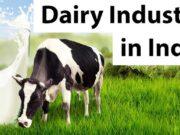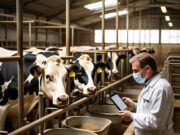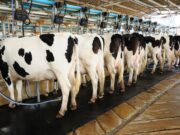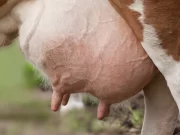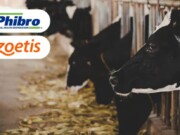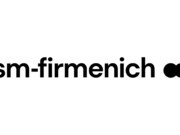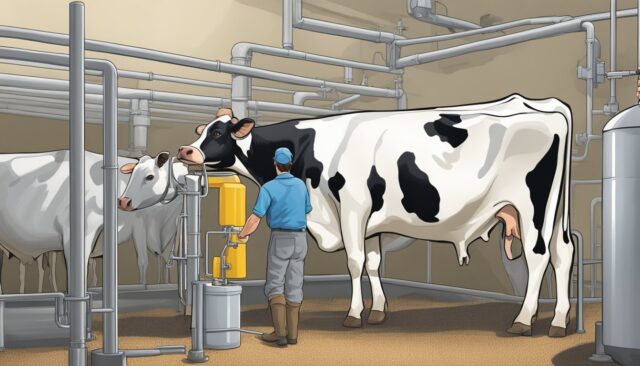
Mastitis among dairy animals poses significant challenge in dairy farming, affecting not only animal welfare but also the economic viability of dairy operations. The economic losses associated with bovine mastitis are multifaceted. They include direct losses from decreased milk production, discarded milk during treatment, and increased veterinary and labour costs. Indirect losses may result from reduced milk quality, leading to lower milk prices, and potential culling of severely affected animals. From an animal welfare perspective, mastitis causes pain and distress to affected cows. Addressing animal welfare concerns is not only ethically important but can also influence consumer perception and marketability of dairy products. The classification of mastitis into clinical, sub-clinical and chronic categories helps in understanding the severity and implications of the disease, treatment and management strategies.
Clinical Mastitis
Clinical mastitis is characterized by visible signs of inflammation in the udder such as swelling, redness, warmth and pain. Affected cows may also exhibit systemic symptoms like fever. The milk appears abnormal, often watery and contains flakes, clots or blood. Based on the severity and progression of symptoms, clinical mastitis can be divided into
- Peracute Mastitis: This form is extremely severe and progresses rapidly. Symptoms include a high fever, toxaemia and the cow may be severely ill. The udder is usually very swollen, hot and painful. Immediate veterinary intervention is critical.
- Acute Mastitis: Symptoms are less severe than peracute but still include noticeable changes in the udder and milk, alongside mild to moderate systemic illness.
- Sub-Acute Mastitis: This form is milder with less pronounced symptoms. The cow may not appear to be significantly ill, but changes in the udder and milk can be observed.
Sub-Clinical Mastitis
Sub-clinical mastitis is more insidious as it presents no visible signs of infection or inflammation in the udder and the milk appears normal to the naked eye. However, it can be detected through an increase in the somatic cell count (SCC) in the milk, a key indicator of mastitis. This form is particularly concerning as it can go unnoticed while still affecting milk production and quality, leading to economic losses.
Chronic Mastitis
Chronic mastitis refers to cases where the infection and inflammation persist over a long period. This can be due to either a failure to fully resolve clinical or sub-clinical mastitis or a low-grade, persistent infection. Cows with chronic mastitis may have recurring episodes of clinical mastitis or continuously elevated SCC without showing typical symptoms of infection.
Risk factors of mastitis
The incidence of bovine mastitis is influenced by a complex interplay of pathogens, host and environmental factors. Understanding these factors is crucial for effective prevention and control strategies.
1. Pathogen factors
The bacterial infections can be classified into contagious and environmental pathogens based on the bacterial origin.
Contagious Mastitis Pathogens
Contagious mastitis is primarily spread from cow to cow, most commonly during the milking process. Key features and control strategies include:
- Pathogens: The main bacteria responsible are Staphylococcus aureus, Streptococcus agalactiae, Mycoplasma bovis and Corynebacterium species. These organisms typically colonize the teat skin and canal, leading to infection.
- Transmission: Mainly occurs through contaminated milking equipment or hands, emphasizing the need for strict hygiene practices.
- Detection: Elevated somatic cell counts (SCC) in milk are a hallmark of infection, signaling an immune response to the intramammary infection.
Control Measures:
- Milking equipment maintenance: Regular cleaning and maintenance to minimize bacterial transmission.
- Post-milking teat disinfection: Crucial for killing pathogens on the teat skin immediately after milking.
- Culling: Removing chronic carriers from the herd to reduce the reservoir of infection.
- Dry Cow Therapy (DCT): Treating cows with antibiotics during the dry period to eliminate existing infections and prevent new ones.
Environmental Mastitis Pathogens
Environmental pathogens are not typically found on the cow but in the cow’s surroundings, such as bedding and housing. These infections are characterized by:
- Pathogens: Include Escherichia coli, Streptococcus uberis and other coliforms like Klebsiella spp., Enterobacter spp. and Pseudomonas spp. These bacteria are opportunistic, exploiting situations where the cow’s defence mechanisms are compromised.
- Transmission: These bacteria can infect the teat through environmental contact, especially in situations where hygiene is compromised, such as dirty bedding or during the cow’s lying down.
Control Measures:
- Environmental hygiene: Regular cleaning of the housing and bedding areas to reduce exposure to pathogens.
- Teat end care: Keeping the teat ends clean and dry to prevent bacterial entry.
- Boosting immune resistance: Through nutritional management, stress reduction, and possibly vaccination, to enhance the cow’s natural defences against intramammary infection.
- Antibiotic intervention: Judicious use of antibiotics can treat existing infections and prevent new ones, especially in high-risk situations.
2. Host Factors
- Breeding and Genetics: Certain breeds such as Holstein-Friesian are more susceptible to mastitis than others. Genetic factors influence susceptibility or resistance to the disease, with high-yielding breeds typically more at risk.
- Udder structure: The physical characteristics of the udder such as teat size and shape can affect mastitis risk. Cows with certain udder and teat conformations are more prone to developing infections.
- Age and parity: Older and multiparous cows are more susceptible to intramammary infections likely due to anatomical changes from repeated milking and calving.
- Transition period: The periparturient period is a high-risk time for developing mastitis, associated with immunosuppression and increased oxidative stress.
- Nutritional stress and Immune system: Inadequate nutrition, especially during high-demand periods like lactation, can lead to immunosuppression and increased susceptibility to infections. Supplementing with vitamins and trace minerals can help bolster the immune system.
3. Environmental Factors
- Herd management practices: Cleanliness, ventilation and overall management practices significantly impact mastitis incidence. Proper environmental conditions reduce pathogen growth and exposure.
- Stocking density and Bedding: High stocking densities and poor bedding conditions can increase mastitis risk by promoting pathogen proliferation and transmission.
- Climate: Extreme weather conditions, both hot and humid or very cold, can stress the animals and indirectly increase the risk of mastitis.
Management and Prevention
Effective mastitis control and prevention hinge on a comprehensive understanding of these factors and implementing integrated management strategies that address each area. By focusing on improving host resistance, minimizing pathogen exposure and creating optimal living conditions, dairy farmers can significantly reduce the prevalence and impact of mastitis in their herds. Effective management and prevention of mastitis require a comprehensive approach, including:
- Good Milking Practices: Proper milking techniques and hygiene can significantly reduce the incidence of mastitis.
- Regular Monitoring: Somatic cell count testing and visual inspections can help in early detection, especially of sub-clinical mastitis.
- Environmental Management: Keeping the living and milking environments clean and dry reduces the risk of infections.
- Appropriate Treatment: Timely and appropriate use of antibiotics, under veterinary guidance for infected animals is needed.
- Culling: In some cases, culling of chronically infected animals may be necessary to control the spread of infection.
1Jinu Manoj, 2Indu Panchal and 3Manoj Kumar Singh
1Disease Investigation Officer, College Central Laboratory, COVS, LUVAS, Hisar, Haryana
2Assistant Professor, CODST, LUVAS, Hisar, Haryana
3Assistant Professor, COVAS, SVPUAT, Meerut, Uttar Pradesh
